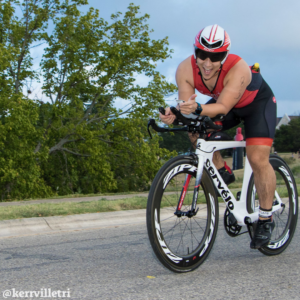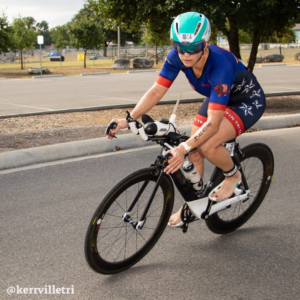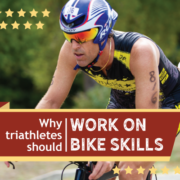Why Triathletes Should Work on Bike Skills
Improve as a cyclist and ride as safely as possible when you master these bike skills
It is not “just riding a bike.” Everyday bike skills will not make you a better cyclist, but they can provide the foundation for you to improve. For triathletes, you can’t take advantage of speed if you don’t master certain bike skills like shifting gears and handling turns. In triathlon, every second matters. If you can get better at handling your bike, then you can potentially shave minutes off your time. Ride safely and improve as a cyclist when you master these bike skills. Pro tip: for added safety, memorize and follow the cycling rules of the road.
Practice these bike skills
Be energy efficient

Riding in an aero position allows you to be more energy-efficient. Credit – Ed Sparks
When you ride fast, aerodynamics play against performance by way of air and wind resistance. Proper body positioning on the bike can reduce wind resistance and make you more energy efficient. The smaller you can make yourself on the bike, the less wind resistance. If you can continue to maximize your power output in this position, you’ll save more energy for the rest of the ride and the upcoming run. Pro tip: minimize the amount of time you’re sitting up and stay in the aero bar more to reduce wind resistance.
Shifting gears
The difference between a pro and an everyday cyclist is their ability to shift gears at the most appropriate time. This is a skill that most triathletes may take for granted.
Below are the three secrets in exploiting situations using gear shifting skills
- Climbing: Don’t go to an easy gear directly. Shift gears in their sequence as the climb advances to maintain momentum and efficiency.
- Change gear after accelerating: You know from experience that it is easier to rev a fast gear than a heavy gear. Increase the tempo of the gear to shift into a heavier gear to overtake or a similar maneuver.
- Heavy gear: While riding with a group, change to a bigger gear for a steadier pace that saves energy.
Passing other cyclists

Get out as wide as you safely can when handling a corner. Credit – Ed Sparks
As a USAT-sanctioned event, Kerrville Triathlon abides by all of their rules. The passing rules should be followed on training rides too.
- Keep three lengths between the cyclist in front
- Pass on the left, never the right
- Complete within 15 seconds
Handling corners
Mastery over this skill can help you maintain as much speed as possible. Follow the below steps to maneuver corners like a pro.
- Launch into a corner in an open curve
- Hook the peak point of the bend
- Get out as wide as you safely can
- If you need to slow down, do it before entering the corner
- Never apply brakes while in the bend
Hydrating

Make sure you have plenty of hydration with you for longer rides. Credit – Ed Sparks
This is often the toughest skill to master for most cyclists. When practicing this, start off at a slower speed and build your way up. If your bottle is in a rack below you, get some speed and stop pedaling. As you coast, focus on your balance. With the hand you’re most comfortable with, reach down and grab your bottle. Maintain balance of the bike with the other hand. Drink and place the bottle back. Repeat as necessary until you become more familiar. Increase speed and add pedaling as this move becomes more natural. Pro tip: this blog further breaks down how to hydrate while you ride and highlights the best items for just that.
Fixing a flat
Don’t get caught stranded because of a flat tire. This information is valuable whether you’re racing or on a long training ride. To fix the flat tire of a bike, follow the below procedure. Make sure you’re prepared for anything and when you have these essential items in your saddlebag.
- Remove the wheel from the bike and take out the tube
- Closely inspect to find the puncture, check for embedded objects
- Replace the tube with a spare or patch it up
- Put everything back and continue riding
Set aside time every day to practice these bike skills. You will get better over time, especially as you become more familiar and comfortable with each skill. Before you know it, you’ll show others the tricks you come up with to make cycling easier for yourself.









